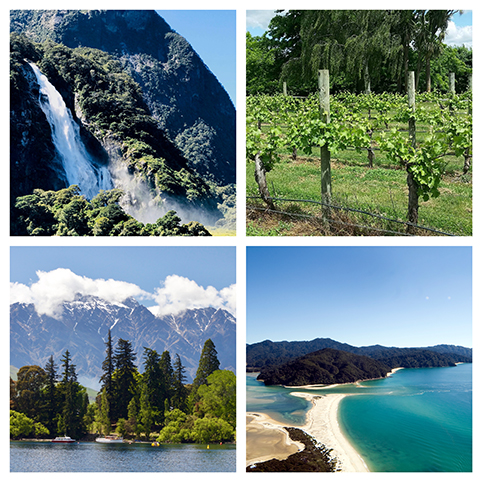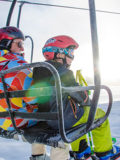
Photos: ActiveAdventures.com
September is Healthy Aging Month and there’s no better time to think of new ways to stay active. Do you like to travel? Then make it an active travel adventure. Discover new places, meet new people and be active while you do it.
Sure, you want the great meals, relaxing moments by a pool, lake or ocean. But all of that is so much more rewarding after a day of activities … like walking!
Be active! We are not saying you have to hike to the top of Mount Kilimanjaro … how about starting small and around the block.
Every day.
Make it a goal to increase your walks. Every day.
The reward? Plan a walking trip as the big payoff. Yes, ditch the car and plan a trip to explore a destination on foot.
Need an idea? Try a walking tour in New Zealand where the route, hotel and meals are all planned for you. You just need to arrive and enjoy the walk.
You might enlist the aid of a professional tour operator like ActiveAdventures.com. We especially like their Active Adventures Elegant South trip — The 11-day journey takes you through picture-perfect coastal areas at the top and bottom of the island. Sandy beaches, crystal-clear water, beautiful coves and inlets,rain forest while “roughing it” (not!) in secluded lodges and enjoying local foods.
My kind of payoff for walking!

Hiking in New Zealand. Photo: ActiveAdventures.com
Preparing for a Hiking Adventure: 8 Fitness Tips for the 50+ Explorer
Ideas from ActiveAdventures.com
“Am I too out-of-shape for an adventure trip?” It’s the number-one question we’re asked by so many travelers inquiring about our trips.
It’s the nagging worry that especially keeps 50+ adventurers from taking the plunge on the vacation of their dreams – and that’s a shame, because anyone who loves the outdoors is a good candidate for an adventure tour.
Of course, that doesn’t mean there aren’t things you can do to prepare before your trip to make it more enjoyable. A little investment in your overall fitness before you go pays big dividends in terms of what you can accomplish out on the trail.
That doesn’t mean you have to join the gym or punish yourself with a triathlon-level training regimen. There are a lot of common sense steps you can start right now to get yourself ready for the adventure of a lifetime. So if you’re a 50+ adventurer and wondering where to start, try these eight fitness tips to give yourself the confidence to achieve your personal goals.
1. Give yourself time to prepare.
In general, it can take your body from three weeks to three months to really see a significant improvement in your fitness level and to respond to a change in routine. So if you’ve already booked your trip, you’d best get started now!
2. Focus on your cardiovascular fitness.
The American College of Sports Medicine recommends at least 150 minutes of aerobic activity a week for people 50+ with at least 30-minute sessions at a time.
The best aerobic activities for mature athletes are swimming, cycling, brisk walking or jogging—all of which are great preparation for an adventure like exploring Peru and Machu Picchu.
Even if you can’t get outdoors or make it to the gym, there are lots of great cardio exercises you can do at home to get your heart pumping. Jumping jacks, half-jacks, squats, leg raises, hops, and even plank-jacks are great bodyweight exercises that require no special equipment or skill.
If you’re doing a hiking adventure (like Mt. Everest perhaps), high-intensity interval training (HIIT) is particularly beneficial because it improves both aerobic and anaerobic fitness and prepares your body for the bursts of strength you’ll need on your climb.
HIIT sounds more complicated than it really is – it’s simply adding a short period of more strenuous exertion into your daily walking, jogging, swimming, or biking routine. For example, if you take a 45-minute brisk walk, try to jog for 30 to 60 seconds every 5 to 10 minutes of your walk. Same if you swim or bike – add a few sprints during your usual routine.
A note of caution for you mountain adventurers: Even if you’re in pretty good shape, it’s important not to push yourself too hard at higher altitudes. Exertion is a key driver of altitude sickness.
3. Focus on leg strength.
Strength training is generally a good idea for athletes of all ages, but for hikers, leg strength is essential for an enjoyable experience. Your legs are doing the bulk of the work, after all.
Lunges, squats, and calf-raises are all good exercises you can do at home. Try slowly stepping on and off a step or exercise platform, gradually increasing the height as you progress.
Setting your treadmill at a higher incline is also great preparation – or just walking up a few hills on your evening stroll.
4. You need a strong back to carry your pack.
Your adventure pack and a few bottles of water are a portable gym to help you get in shape just about anywhere. Strap on your pack and practice “step ups”. This will really get your calves and back ready for the weight you’ll be carrying on a hike! Walking up and down the stairs with your pack is also great training.
Push-ups and planking with a loaded pack build up essential muscles in your core, shoulders, and upper body that you’ll need on longer hikes. Here are some good exercises you can do with your pack to strengthen your back.
5. Don’t neglect your core.
Your core muscles are your abdominal muscles, back muscles, and the muscles in your pelvis and they give you balance and flexibility – and underpin just about every other physical activity you’ll do on an active adventure.
Crunches, bridges, and planks are some of the best exercises to build a strong core. You can tune up your core by sitting on an exercise ball while you read or watch TV at night; step up your core fitness game with these stability ball exercises.
6. Keep it balanced.
This sounds too simple to mention, but a few minutes spent improving your balance can prevent injuries on your trip and give you more stability when you climb. Walking heel-to-toe with your arms out at your side and your eyes looking straight ahead is an easy and effective balance exercise. So is simply standing on one foot for 30-60 seconds at a time (longer if you can manage) before switching to the other foot.
Here’s a great video with some easy exercises to improve your static and dynamic balance (and you’ll need both on the trail).
7. Don’t forget the practice hikes.
Now’s the time to put all those exercises to work for you with a few practice hikes. Look for places with variable terrain and elevation so you can get the feel for how your body responds to the stresses – and areas where you may want to improve.
Remember to wear your pack and toss in a few water bottles, adding more as you progress, so you get used to handling your body with a weighted pack.
The practice hikes are essential for one more extremely important reason: You’ll get a chance to break in your boots – or buy a new pair if the ones you have aren’t supporting you correctly. There’s nothing worse than hitting the trail with a pair of painful, poorly fitting boots.
Remember that new boots rarely feel great right out of the box. The lighter models may break in with just a few hikes, but some of the sturdier leather ones may take weeks to really conform to your feet. Keep that in mind if you’re considering a new pair of hikers before your trip.
8. Mental preparation is important, too.
Fear is the enemy when it comes to trying something new. Combat it with physical preparation – knowing you’re doing positive things to get your body ready for the trip.
Focus on the “why,” the personal benefit you hope to attain by completing an adventure: “I want to hike the Inca Trail because I will _______________________.” Keep that benefit firmly in mind when you’re feeling discouraged, both in your preparations and on the trail.
Finally, visualize success. See yourself standing on the vast Tibetan Plateau or hiking Grey Glacier in Patagonia. Seeing success is the first step toward achieving it.
Don’t be afraid of a little self-doubt – it happens to everyone, even the most well-prepared. But you can combat it by knowing why you’re taking an adventure tour in the first place and what success looks like to you.
Of course, a really knowledgeable and supportive trip leader can make all the difference, too.
Final thoughts…
You don’t have to be in the best shape of your life to have a memorable and successful adventure tour. But it helps to give yourself confidence with a little preparation before you go. Just remember – no matter how you feel when you leave, you’ll return renewed, refreshed, and alive with a sense of accomplishment.
For further information, contact ActiveAdventures.com











